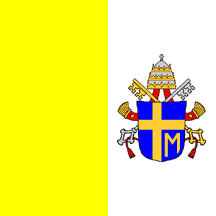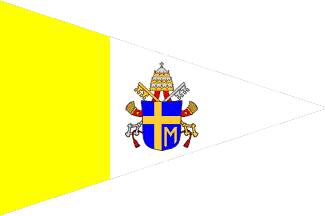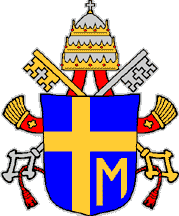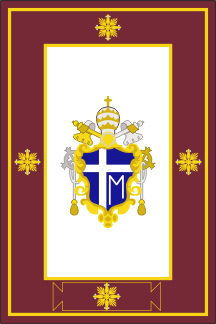
image by António Martins, 8 November 2001

Last modified: 2013-12-14 by rob raeside
Keywords: vatican | holy see | pope | catholic |
Links: FOTW homepage |
search |
disclaimer and copyright |
write us |
mirrors

image by António Martins, 8 November 2001
On this page:
See also:
I just saw in the news a short coverage of an Vatican meeting
where the Pope came by car that was addorned with two flags that
were sometimes reported as Pope's personal flag. There were of
the same design as the state flag of Vatican, but the Vatican
Coat of Arms being replaced with the papal personal Coat of Arms (blue, golden cross and letter M) of
Pope John Paul II.
Even if these flags are somtimes (rather often?) seen in various
occasions, I think that this is first time I have seen them used
by the Pope himself or the Vatican government - otherwise these
flags were always seen (more or less) as ornamentation hoisted
by Catholics in various occasions. The two flags on the car
were rather in the triangualr pennant form, with the white fields
therefore being considerably larger then the yellow field, so
that it could contain the CoA confortably.
Željko Heimer, 21 May 2001
The square, yellow-white "flag" with John Paul's
arms which appears on the is more difficult for me to address. I
left Rome in 1994 and have never seen it. I assume that you have
seen it used as a "car flag," which is not out of the
question. Again, I doubt there are legal directives in its
regard. I am confident, however, that it would never be displayed
from any Vatican buildings as a full-size flag in any official
capacity.
Rev. William M. Becker, STD, 30 June 2004

image by António Martins, 8 November 2001
The pope uses several different motor vehicles, which display
either the regular Vatican flag, or a special pennant. For John
Paul, the pennant is correctly pictured here: yellow-white with
the papal arms on the white stripe. For Paul VI, it was
yellow-white with the papal arms in the middle.
To my knowledge there are no official directives specifying the
exact design of the pennant. I suspect its precise design is a
matter of tasteful liberty for the attendants of the papal
household. Because, however, it appears on the pope's own
vehicles, I would call it "semi-official." Nor do there
seem to be directives concerning when the pennant is used on
motor vehicles, as opposed to the regular Vatican flag. I suspect
that the custodian of the vehicle who is on duty for the occasion
simply decides by himself which banner to affix to the car. In
recent years it usually seems to be the pennant; but sometimes it
has been the regular Vatican flag (e.g., when the pope was shot
in 1981).
Rev. William M. Becker, STD, 30 June 2004
The yellow-white pennant used on motor vehicles carrying John
Paul II bears his personal Coat of Arms on the
white stripe (i.e., his personal shield-of-arms supported by the
tiara-keys emblem), not the simplified tiara-keys emblem.
Rev. William M. Becker, STD, 27 August 2004
At <www.nytimes.com>
there is a picture from a new TV movie about the late Pope John
Paul II. Behind Jon Voight (as the Pope) is a flag being waved by
a spectator that places the Pope's own arms in the center
(perhaps slightly to the fly) of a horizontal white over yellow
flag. It may be a TV mistake, or maybe it was a real-life one
that was copied.
Nathan Lamm, 28 September 2005
Much more likely is that the flags held by the supporting
artistes are deliberately made to look very similar to, but
slightly different from, the official flags. Such a
practice is very common in the film and television industry when
making props. See also the following John Paul II hand flag
variant photographs (here
and here) taken in Rynek
Glowny, Kraków, on the day of his funeral, 8 April 2005. Kraków
is the city where the late Pope went to University and was
Archbishop from 1964. There were extensive tributes to the late
Holy Father in virtually every business window in the city centre
and floral tributes in public spaces in the city, many of which
also incorporated small flags. These flags were also
carried by the many thousands of people attending an open air
Mass at Blonia Common, where television coverage of his funeral
was being relayed. I did not witness any flags such as those in
the photograph of Jon Voight, from the New York Times web site,
but there were undefaced horizontal white over yellow bicolours.
Colin Dobson, 30 September 2005

image by António Martins, 8 November 2001
John-Paul II has a blue shield with golden cross off-centered
towards dexter chief, with a golden 'M' in sinister base field.
The 'M' stands for Mary, Mr. Woyti³a's personal devotion. Above
the shield there is a papal tiara (three times crowned hat), and
behind shield are crossed golden and silver keys.
The image was made from a promo material from the 1978 papal
visit to Portugal: I recolored from a b/w Petra Santa large sized
image.
António Martins, 8 November 2001
Note that the cord should be red, also all of the gems in the
tiara. The ribbon emerging from the tiara will be red, too, with
golden crosses and golden fringes. A pretty good source for
symbols of the Catholic church might be named: Peter Bander van
Duren (ed.): Armorial Bruno B. Heim [hei81],
Van Duren, Gerrards Cross, England, 1981.
Željko Heimer, 16 May 1996, Dieter Linder, 29
May 1997
In effect, the Arms of HH JOHN PAUL II are not only famous but
singular into Papal Armorial. The Azure (blue) field charged with
a dextered flat cross accompanied by a "M" on sinister
canton of the base was initially on Sable (black), which is
explained because on German School and those that are subject to
their influence (the Polish one, for example) seems not to have
the same rigor with respect to the application of the classic
heraldic parameters and into this specific case, we can note an
evident lack to the Tinctures' Canon
(Saber on Azure, color on color). When His Eminence Cardinal
Wojtyla was enthroned Pope, Monsignor Bruno Bernard Haim (Great
Heraldist and In-Charge of Vatican Armorial) suggest to replace
Sable by Or (yellow).
Now, the Cardinal enthroned Pope maintains his Arms but naturally
changing its external ornaments, replacing the red cap as crest
which two games of tassels at flanks more another attributes that
corresponds with the Cardinal dignity with the Tiara (closed
mitre with ovoid form and three crowns, everything in Gold) over
the Chief and the two crossed keys (one of Gold and another one
of Silver) disposed behind the field in saltire and rolled by
cord in Gules (red). Once takes place the outcome that lamentably
is imminent [i.e., the death of Pope John Paul II], the Arms of
HH John Paul II will mantains the Tiara but will omit the keys,
since these symbolize the government of the Church as much
Sovereing State as Religious Institution, alluding naturally to
the "keys of the Kingdom of the Heaven" that Our Lord
Jesus Christ gave to Saint Peter constituing him First Pope.
Meanwhile "Vacant Seat" takes place (transition between
the decease of a Pope and election of its successor) the Church
Government was in charge of Cardinal School and all the
Eclesiastic Hierarchy; nevertheless, to the State effects, is
assumed by to so called "Camarlenge Cardinal" who
during the exercise of his functions will may use as Ensign of
his dignity the Papal Umbrella: it's in effect, an umbrella
enameled in Or and Gules and singularly ornamented.
Raul Pardo, 2 April 2005
I saw a documentary on television a few days ago. As
incredible as it might sound, the late Pope John Paul II did not
seem to have a coat-of-arms when he was a Cardinal. When he
became Pope, he had to have a coat-of-arms, and he proposed a
blue shield with a golden cross (for Jesus Christ) and a golden
letter "M" (for the Blessed Virgin Mary). His advisor
told him that heraldically it does not make sense to put a letter
on a shield. The Pope, whose Polish Catholic tradition stresses
devotion to the Blessed Virgin Mary, replied that it does not
make sense for him not to put the letter "M" onto the
shield! That's why Pope John Paul II's coat-of-arms had letter
"M" on the shield, contrary to standard heraldic
practice.
Miles Li, 20 April 2005
According to Rev Guy Selvester, who is something of an expert
on ecclesiastical heraldry, this is not quite
correct. As Archbishop of Cracow, Karol Woyti³a used
a shield similar to the one he used as Pope, but with the charges
black on blue rather than gold on blue. The Vatican heraldic
expert Archbishop Bruno Heim was able to persuade him to alter
the colors to the more heraldically correct gold on blue, but not
to change the design.
Joe McMillan, 20 April 2005
Exactly so. Moreover the presence of the letter 'M' is not
unheraldic at all (the most you can say is, that it is unheraldic
in a number of countries) and remember that John Paul II did not
adopt the traditional Italian 'horsehead' shield.
Jan Mertens, 20 April 2005
At <www.sca.org>
it is suggested that "enhanced to sinister chief"
should be the blazon of the off-center cross.
Ned Smith, 22 April 2005
If blazoned this way at all, it is "enhanced to dexter
chief," and if enhanced one doesn't have to specify
"chief.". My heraldic colleague Fr. Guy Selvester
suggests "a Latin cross throughout skewed to
dexter." The ecclesiastical heraldry page of the
website of the Italian Heraldic-Genealogical Institute gives
"D'azzurro alla croce d'oro, il montante posto verso destra
e la traversa alzata, accompagnata nel canton sinistro della
punta da una "M" dello stesso." I think
the corresponding English blazon would be "Azure a cross or,
the upright placed to dexter and the crossbar enhanced, in
sinister base an M of the same."
Joe McMillan, 22 April 2005

image by Juan Manuel Gabino Villascán, 19 April 2005
Here is a reconstruction of the "gonfalone", or
standard used in Saint Peter's Square, during the proclamation of
the new pope Benedict XVI.
Juan Manuel Gabino Villascán, 19 April 2005
The arms thereon are those of John Paul II.
Albert S. Kirsch, 19 April 2005
According to <www.rian.ru>
during statement of HH Pope Benedict XVI in front of people which
have gathered on the square, right after his elections on a
loggia of a cathedral of St. Peter, it has been still hung out
cloth with the image of the coat of arms of HH Pope
John Paul II.
Mikhail Revnivtsev, 20 April 2005
It's amazing how many people assume those are just the Papal
arms. Since the death of John Paul II, CBC News (at least, but
that's the only news I've watched lately) has used John Paul II's
arms as a small "icon" on the screen whenever
Pope-related stories come on, news about his funeral, about the
College of Cardinals voting, and even, strangely (to me), at the
announcement of a new one!
David Kendall, 20 April 2005
The coat of arms showed on the occasion of the presentation of
the new pope is similar to the coat of arms of John Paul
II, but it is not the same - the cross and M are there white
(argent) unlike in J.P.II's where they were golden (or). Such
difference makes it a new coat of arms entirely.
Moreover, the thing hunging from the balcony is not a flag nor a
gonfanon nor anything of vexillologic primary interest. The thing
is rather a carpet or a tapestry, as was clearly visible while
they were installing it there.
Željko Heimer, 20 April 2005
I thought the same thing the first time I saw the picture, but
if you compare the cross and M with other white/silver areas of
the tapestry (the silver areas of the tiara and the silver key),
it's clear that they are not the same. I think the yellow/gold on
the shield is just very light, possibly from fading, possibly a
function of blue filters on the camera, or whatever - but
nevertheless not white.
Joe McMillan, 21 April 2005
I'm sure that Joe McMillan's explanation must be the
correct one. Note the image of John Paul II's arms at <www.catholic.org>.
While the charges are clearly Or they are also clearly a much
lighter shade of gold than the frame around the shield.
In a photo at <www.paulines.ph>
from the beatification ceremonies of Father Giacomo Alberione, 27
Apr 2003, you can see that the charges on the papal arms do
appear argent, even back then. It is probably just an illusion
caused by the lighting and contrast with the darker shade of the
frame around the shield.
Ned Smith, 21 and 22 April 2005